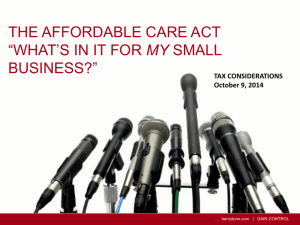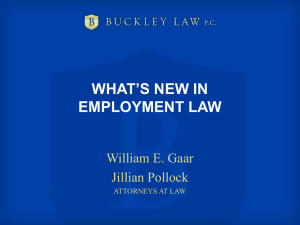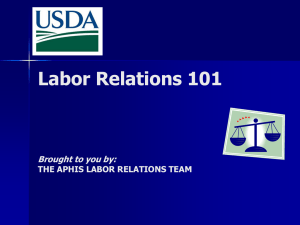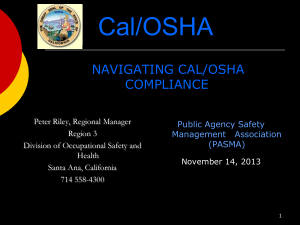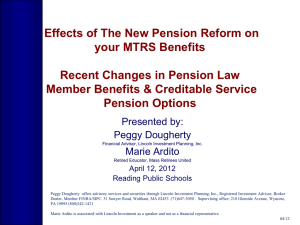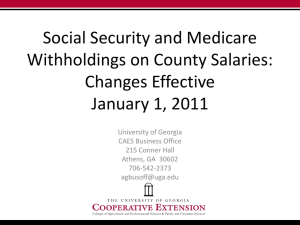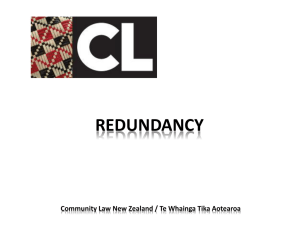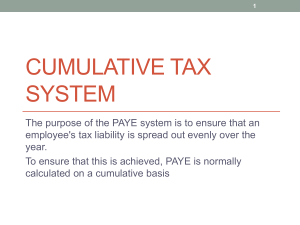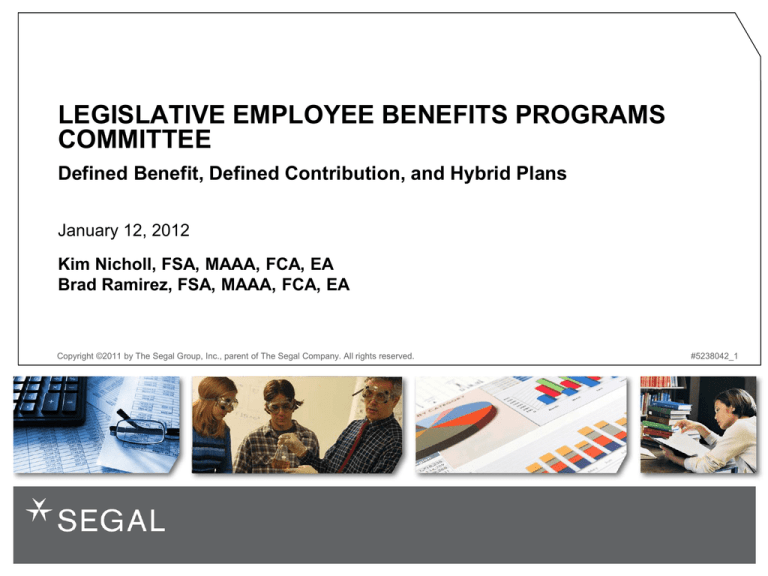
LEGISLATIVE EMPLOYEE BENEFITS PROGRAMS
COMMITTEE
Defined Benefit, Defined Contribution, and Hybrid Plans
January 12, 2012
Kim Nicholl, FSA, MAAA, FCA, EA
Brad Ramirez, FSA, MAAA, FCA, EA
Copyright ©2011 by The Segal Group, Inc., parent of The Segal Company. All rights reserved.
#5238042_1
Discussion Topics
Defined Benefit/Defined Contribution
Segal
Hybrid Plan Designs
Hybrid Examples and Recent Trends
1
Defined Benefit versus Defined Contribution
Under a DB plan, the benefit is defined and the contribution is not
Under a DC plan, the contribution is defined, but the benefit is not
Types of plan risks:
Investment risk
Inflation risk
Contribution risk
Longevity risk
In a DB plan, the employer usually bears these risks
In North Dakota, the employee bears a portion of these risks
In a DC plan the employee bears these risks
A hybrid plan is a combination of a DB and DC plan
2
Definition of Risks
Investment Risk
Rate of return on assets
In DB plan, employer usually bears all the investment risk
In DC plan, employee bears all the investment risk
In North Dakota, contribution rates are fixed for both employer and employee
The employer and employee contribution rates are scheduled to increase for PERS and
TFFR, so both employer and employee are sharing the investment risk
Inflation risk
Cost of living before and after retirement
DB plans usually based on final average salary, so employee has limited cost of living risk
Most public sector DB plans provide some form of post-retirement benefit increase, so
employee has some protection against inflation in retirement
PERS and TFFR are based on final average salary, so employee has limited cost of living
risk prior to retirement
PERS and TFFR do not have post-retirement benefit increases, so employees bear the
inflation risk after retirement
3
Definition of Risks continued
Contribution risk
Level and volatility of annual contributions
In DB plan, employer usually bears this risk
In DC plan, contributions are a percentage of salary
– If investment returns are poor, employees may need to make additional contributions
The employer and employee contribution rates are scheduled to increase for PERS and
TFFR, so both employer and employee are sharing this risk
Longevity risk
Outliving retirement assets
In DB plan, benefits paid as life annuity, so employer usually bears all risk
In DC plan, benefits based on account balance, so employee bears all risk
The employer and employee contribution rates are scheduled to increase for PERS and
TFFR, so both employer and employee are sharing this risk
4
North Dakota Plans
TFFR is a defined benefit plan
Defined benefit based upon service and final average salary
Deferred vested, disability, and death benefits are also available
PERS Judges, HP, and Job Service are defined benefit plans
Defined benefit based upon service and final average salary
Deferred vested, disability, and death benefits are also available
PERS Main, National Guard, and Law Enforcement plans are hybrid plans
Defined benefit based upon service and final average salary
Portability Enhancement Provision (“PEP”) – allows a member to vest in employer
contributions in the hybrid plans
Requires participation in a deferred compensation plan (457/403(b))
Dollars contributed to DC plan are matched by vested employer contributions subject to a
vesting schedule (up to 4% after three years of service)
Deferred vested, disability, and death benefits are also available
5
Comparison of DB and DC Plans
Objective
Defined Benefit
Defined Contribution
Funding
Certainty
Plan liabilities change based on actuarial
assumptions, e.g., future salary increases,
investment earnings, employee turnover.
Employer liability is fulfilled annually as
contributions are made to employee accounts
based on a percentage of payroll.
Predictable
Contributions
Annual contributions may vary from year-toyear based upon actuarial assumptions. Rates
may be set by statute to increase predictability.
(These rates may need to be changed
periodically.)
Annual cash expenditures are more predictable as
they are based on a set percentage of employee
salaries.
Recruitment
Tool
Some portability through service credit
purchase or return of employee contributions.
Assets are portable.
Reward Career
Employees
Benefits are typically based on final year(s)
salary, rewarding career employees.
Benefits are based upon accumulated
contributions and earnings.
Expenses
Expenses include actuarial valuations,
investment fees, and administrative fees.
Employer pays these fees.
Employee expenses may be lower than a defined
benefit plan because no actuarial valuations are
necessary and investment fees are shifted to the
employee. Employee education costs may be
higher.
6
Comparison of DB and DC Plans
Objective
Defined Benefit
Defined Contribution
Benefit Potential
Benefits paid at retirement are for life and are
guaranteed by the plan’s benefit formula.
Benefits paid at retirement are based on contributions
and earnings. The final retirement benefit can be
eroded by pre-retirement distributions.
Understandable
Benefits
Benefits require explanation because they are
based on a set of variables, e.g., future
earnings and year of service at retirement.
Benefits are based on accumulated contributions plus
earnings at the time of retirement. Market fluctuations
and life expectancy make it difficult to manage
retirement benefit.
Access to
Benefits While
Employed
Benefits may not be withdrawn while actively
employed.
Benefits may be withdrawn or loaned under certain
circumstances.
7
Public Sector Defined Contribution Plans
Alaska
In 2006, the DB plans were closed and new DC plans were established for public employees
and teachers
Non-vested employees in the DB plans were permitted to transfer to the DC plans
Employees contribute 8% of pay
Non-teacher employers contribute 5% of pay and teacher employers contribute 7% of pay.
West Virginia
In 1991, DB plan was closed and a new DC plan was created
– Employers contributed 7.5% and employees contributed 4.5%
The DC plan was closed to new members in 2005
In 2006 members of the DC plan voted to merge with the DB plan
Effective in 2008, members in the DC plan were permitted to elect to transfer back into the
closed DB plan – 80% elected to transfer back to the DB plan
Michigan
In 1997, the DB plans were closed to new members and a DC plan was made mandatory for
state employees hired after that date
– The State contributes 4%, and will match an additional 3% (a maximum of 7%). Employees are not
required to contribute but may contribute up to 12%
Members of the closed DB plan were allowed to transfer to the DC plan
8
North Dakota PERS Defined Contribution Plan
Approximately 290 members (226 are active)
Participants are allowed to direct contributions to over 30 investment options
A self-directed brokerage option is also available
Plan is benchmarked to PERS hybrid plan goal of providing a career employee (25
years of service) a benefit of approximately 50% of final average salary at retirement
A recent study compared projected DC benefits to the PERS hybrid plan
To address the funding challenge of providing adequate benefits, a 2% contribution increase
was proposed for each year from 2012 through 2015 in SB 2108. The 2012 and 2013
increase was approved. The 2014 and 2015 increases were deferred for future
consideration.
9
What Is a Hybrid Plan?
A combination of a defined benefit plan
and
a defined contribution plan
10
Reasons Hybrids are Considered
Lower employer costs
Reduce employer contribution volatility
Provide greater benefit flexibility, especially for short service
employees
Increase portability
Make the plan more understandable
Modify the risk characteristics of the benefit offering
11
Hybrid Plan Considerations
DB and DC plans have very different approaches to benefit design
DB plans focus on benefit security
DC plans focus on wealth accumulation
Shifting of plan risks may have unintended consequences
There is no magic equivalent plan (DB = DC)
Difference rests in risk and performance
Whether retirement benefits are provided by a DB plan, DC plan, or a
hybrid plan, contributions should be sufficient so that employees have
a reasonable opportunity for a viable retirement plan
12
Menu of Basic Plan Designs
Defined Benefit
Defined Contribution
Final Average Salary
Traditional DC
Career Average Salary
401(k)
Flat Benefit Accruals
403(b)
457
Matching plans
13
Menu of Hybrid Plan Designs
DB plans with lump sum options
Combined plans
Crossover plans
Cash balance plans
14
Combined Plan
Have both defined benefit and defined contribution components
Variations:
Defined benefit is primary plan with defined contribution to
enhance portability
Defined contribution is primary plan with defined benefit as
“safety net” plan
NDPERS “PEP” Provision – enhanced return of contribution
withdrawal benefits, payable as a lump sum
15
Crossover Plan
Members can choose among defined benefit, defined contribution, or
combined plan at hire date
Members have option to “crossover” from one plan to another with
restrictions
In Ohio State Teachers Retirement System, members have option to elect
another plan after 3 or 5 years, default to DB plan unless they affirmatively
elect another plan
PERS non-classified state employees may elect to participate in the DC
plan within six months of the date of employment, otherwise participation
in the DB plan will continue.
16
Cash Balance Plan
Defined benefit plan that looks like a defined contribution plan
Hypothetical account balance credited with percentage of salary and
interest each year.
For example:
Annual credit to account balance of 5% of salary
Annual interest on account balance equal to 10-year treasury rate plus
1.5%
Benefits paid at retirement or termination based on value of hypothetical
account balance
Actual contributions based on annual valuation and expected to be less
than annual credit plus interest
17
Combined Plan Attributes
Allocates portion of the plan risk to the member
Provides additional benefit flexibility to the member
Lowers future contributions for the plan sponsor
Maintains a core DB for the base retirement benefit
Provides a platform for death and disability benefits
18
Examples of Public Sector Hybrid Plans
Combined Plans
Oregon (2003)
Combined DB/DC plan
Tier II:
DB– 1.5% of pay plan employer funded
DC 6% employee funded
Georgia (2008)
Combined DB/DC plan mandatory for new hires
since 2009 and optional for those hired before
2009
DB–1% of pay plan
Employee contributes 1.25% and employer
contributes remainder
DC Employer matches 100% of employee’s
first 1% and 50% of next 4% with maximum
employer contribution of 3%
Rhode Island (2011)
Combined DB/DC plan mandatory for new hires
except for public safety employees and judges
DB–1% of pay plan for teachers and general,
2% of pay for public safety
Teachers and general contribute 3.75%,
public safety contribute 8.75%
DC 5% employee/1% employer (7%
employee/3% employer for teachers)
Cash Balance
Nebraska (2003)
DC plan closed in 2003, replaced with a
cash balance plan for new hires
Employee contribution: 4.8%
Employer contribution: 7.5%
Investment return guarantee:
At least 5% annual return
Potential for additional Board
approved amount
Total not to exceed 8%
19
Examples of Public Sector Hybrid Plans
Combined Plans
Cash Balance
Michigan Public Schools (2010)
For employees hired after 6/30/2010:
DB–1.5% of pay plan
Employee contributions to DB plan based on
graduated scale based on pay
Employer contributes remainder
DC 1% employer contribution and 2%
employee contribution
Utah (July 2011)
Employee Choice of:
Tier II:
DB–1.5% of pay plan (2% for public safety)
15% cap on employer contributions (17% for
public safety). Employees fund any shortfall.
DC funded by “excess” employer contributions
OR
DC 10% employer contributions (12% for public
safety)
20
Transition Issues
Changing from a defined benefit to a defined contribution plan or a hybrid
plan results in transition issues that must be addressed
Unfunded liabilities are not eliminated by a change to a DC plan or a
hybrid plan
Best practices and accounting standards call for accelerated funding,
driving up short-term costs
Longer term asset allocation changes may lead to reduced investment
return and therefore to higher total costs for the plan sponsor.
If DC plan investments are participant-directed, employee education is
needed
Creating a new DC Plan could add administrative complexity and cost
Allowing choice between plans introduces anti-selection issues
Adequate death and disability benefits cannot be provided by a DC plan
Workforce management is difficult with a DC plan
21
Trends in Public Retirement Plan Redesign
Summary of Recent State Plan Changes 1/2010 – 9/2011
Contribution Rate
Changes
COLA
Employer
New Hires
Employee
New Hires
ALL EE
ALL ER (+)
ALL ER (-)
New Hires
Actives
Retirees
Sponsor Contribution
Rules
State
CA, HI, IA, KA, LA, MN, NJ, NM
FL, DE, HI, IA, LA, MN, MO, MS, MT,
VA, VT, WY
AL, AZ, CO, DE, FL, KS, MD, NE, NH,
NJ, ND, NM, OH, TX, VT, WI
HI, ND, NE
AL, AR, CO, FL, NM, OH, TX, VT
CT, HI, FL, IL, MD, MI, MS, KS, OK,
UT, VA
AZ, CT, FL, KA, MD, MS
CO, ME, MN, NJ, RI, SD
IA, LA, MD, NJ, VA, VT
Raise all contribution rates
Reinstate higher contributions based
on funding levels or investment
returns
Suspension tied to funding or CPI
Suspension tied to funding
percentage or investment returns
Elimination tied to benefit amount
Freeze based on service accrual date
Delay start
Retirement after a date certain
Additional contributions to ARC
Require ARC
Earmark pension savings to pay down unfunded
liability
Require payment of the ARC
Longer vesting period
Cap compensation growth in FAS period
Cap on benefit percent or dollar amount
Reduce longevity multiplier or period
Anti-Spiking
New Hires
Actives
AZ, DE, FL, CO, CT, IA, IL, LA, MT, ND*
NH, NJ, NC, ND, MD, VA, WV
Limits pensionable compensation
Longer FAS period
Multiplier
New Hires
Actives
New Hires
GA, HI, MD, MS, MT, NH, NJ, KS
KA, VT
AZ, CT, DE, FL, HI, IL, MN, MO, MS,
MT, NH, NJ, NC, ND*, OK, WV, WI
AZ, CO, CT, ND*, TX
DE, HI, ME, MO, NH, ND*, OK
AZ, CO, ME, ND, VT
AZ, AK, CO, GA, IL, MD, ME, MI, MS,
ND*, NM, SD, UT
Lower multiplier
Rolling rate based on service
GA, IN, MI, UT
RI
NJ, UT
Retirement Eligibility
Retirement Age
Actives
New Hires
Actives
Re-employment
Hybrid
Defined Contribution
New Hires
Actives
New Hires
Change
Lower employer contribution rates
Mandate employee contributions
Prohibit “pick-up” of employee contributions
Raise service requirements
Longer vesting period
Eliminate combined age/service rule
Increase combined age/service rule
Raise normal retirement age
Coordinate with social security normal
retirement age
Eliminate service accrual after rehire
Limit compensation
Combine a lower multiplier DB plan
with a DC account
Suspend pension and health benefits based on
earnings after rehire
Require full contribution
Choice of Defined Benefit, Hybrid, or Defined
Contribution
Part-time workers
Optional
Source: National Conference of State Legislatures, May 2011 and September 2011
* Note that benefit changes applied only to TFFR while contribution changes apply to both PERS and TFFR
22
Questions?
101 N. Wacker Drive
Chicago, IL 60606
T 312.984.8527
Kim Nicholl
knicholl@segalco.com
5670 Greenwood Plaza Blvd, Ste 425
Greenwood Village, CO
T 303.714.9952
Brad Ramirez
bramirez@segalco.com
www.segalco.com
23




